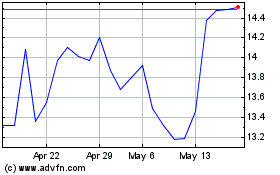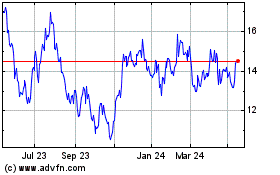By Heather Haddon and Parmy Olson
This article is being republished as part of our daily
reproduction of WSJ.com articles that also appeared in the U.S.
print edition of The Wall Street Journal (June 29, 2020).
In its $7 billion deal to buy Grubhub Inc., a Dutch
food-delivery giant is betting on a strategy it has relied on for
years in Europe: Let restaurants deliver their own food.
Earlier this month, Just Eat Takeaway.com NV swooped in after
Uber Technologies Inc.'s plan to join Grubhub with Uber Eats
foundered. It comes less than a year after Amsterdam-based
Takeaway.com, one of dozens of local online delivery startups that
have emerged in recent years, agreed to buy London-based Just Eat
for roughly $8 billion.
That deal created a publicly listed European colossus with a
North American entry point as Just Eat had earlier bought Canada's
SkipTheDishes. That foothold would grow significantly if the deal
for Chicago-based Grubhub deal goes through, with global sales of
the combined company topping those of Uber Eats, according to 2019
figures.
The rapid deal making has been underpinned by Just Eat
Takeaway's belief that the future of its business lies in having
restaurants handle the delivery part themselves, avoiding the costs
of building fleets of drivers and cyclists to transport meals to
customers.
Both Just Eat Takeaway and Grubhub have some driver networks of
their own, but their businesses revolve around taking a cut from
restaurants and chains that use their websites to advertise and
take orders. U.S. rivals like Uber Eats, DoorDash Inc. and
Postmates Inc. use their own drivers for almost all deliveries.
"We don't put people on bikes," said Jitse Groen, who founded
Takeaway.com in 2000 and took it public in 2016. Last year, it
recorded its first annual profit since its initial public offering,
crediting its "marketplace" model.
Mr. Groen, 42 years old, who would become chief executive of the
combination with Grubhub, describes the approach as based simply on
facilitating messages between restaurants and customers. "As long
as we send messages, we make money," he said. "That's why
marketplace is just a superior business model."
More than three-quarters of Just Eat's deliveries globally are
done by the restaurants themselves, the company says. That has
allowed it to sidestep both the costs of building a fleet and the
logistical and legal headache of managing workforces across
national borders.
It is a tack similar to that taken by Grubhub, which does about
half of the deliveries it processes. Founder Matt Maloney has known
Mr. Groen for years. Conducting talks remotely, they struck their
deal in five weeks, Mr. Maloney said.
Delivery can be the largest expense in an online food order,
amounting to around 25% of an order's overall cost, Grubhub says.
When an online service does the delivery, it passes along the
expense. However, restaurant contributions don't always cover the
cost, especially in the case of big chains, which are able to
negotiate lower rates for themselves.
Independent restaurants, meanwhile, have criticized the delivery
companies for taking cuts of up to 30% to handle their orders.
Mr. Groen says he was attracted to Grubhub's profitable
strongholds in large, densely populated cities like New York. He
recently told analysts that he wasn't in a hurry to expand into
less-dense parts of the U.S., citing Arizona as an example. He said
he can afford to spend a long time competing with rivals who have
established delivery fleets in those places.
"They're essentially giving food away for free," he said on an
investor call. "With logistics, you can't make any money."
Uber Eats said last month that it was profitable in more than
150 cities globally, up from 100 late last year. The company has
exited a number of global markets where it couldn't make money to
focus on the ones where it believes it can.
Just Eat's strategy faces big challenges in the U.S. DoorDash
and Uber Eats have grown much faster than Grubhub, according to
credit-card data from research firm Second Measure. They can more
easily coordinate orders across multiple restaurants and customers
as they have a greater percentage of deliveries done by their own
networks, said Jason Helfstein, an internet analyst at Oppenheimer
& Co.
"We can create a lot of efficiency by actually aggregating the
quality of the logistics needs from many, many restaurants," Uber
Eats Vice President Pierre-Dimitri Gore-Coty said in response to
questions about the company's view of the Just Eat-Grubhub deal at
a tech conference earlier this week.
DoorDash and Uber Eats, in particular, have established
themselves in many American suburbs, building delivery fleets from
scratch through on-demand networks of workers. Many restaurants --
especially those only now exploring delivery -- don't want to hire
delivery workers for the same reason Just Eat and Grubhub try to
avoid them. Drivers can be costly, challenging to manage, and churn
is high.
Restaurants "really want to hand it out," said Brendan Witcher,
a senior analyst with Forrester Research and former restaurateur,
referring to delivery tasks.
Dave Boennighausen, chief executive of Noodles & Co., a
450-unit chain of fast-casual restaurants geared toward suburban
markets, said he prizes the delivery networks provided by DoorDash
and Uber Eats. Both integrated their systems with his chain's order
handling, and orders can be processed more efficiently than if the
restaurants were doing it on their own, he says.
"We've had a good experience with DoorDash and Uber Eats from
that perspective," Mr. Boennighausen said.
Grubhub's Mr. Maloney, 44, said the proposed merger will allow
for more cash to improve incentives for diners and restaurants.
Some restaurateurs are also welcoming the tie-up, hopeful it will
help Grubhub compete better with rivals and provide more
options.
"We would hope it makes them a stronger player," said Scott
Gittrich, president of Toppers Pizza, a 65-unit chain that uses all
of the big delivery services, though he currently does the most
business through DoorDash. "We really want the competition to work
for us."
Write to Heather Haddon at heather.haddon@wsj.com and Parmy
Olson at parmy.olson@wsj.com
Corrections & Amplifications In January 2018, Just Eat
acquired Hungryhouse for $300 million. In September 2018,
Takeaway.com acquired 10bis for $157 million. An earlier version of
the chart in this article incorrectly said Just Eat acquired
Hungryhouse for $157 million and Takeaway.com acquired 10bis for
$300 million. (Corrected on June 28)
(END) Dow Jones Newswires
June 29, 2020 02:47 ET (06:47 GMT)
Copyright (c) 2020 Dow Jones & Company, Inc.
Just Eat Takeaway.com N.V (EU:TKWY)
Historical Stock Chart
From Dec 2024 to Jan 2025

Just Eat Takeaway.com N.V (EU:TKWY)
Historical Stock Chart
From Jan 2024 to Jan 2025
